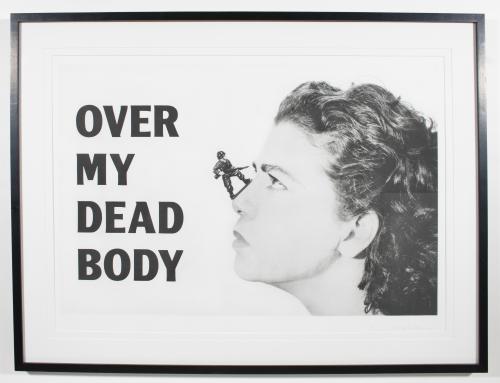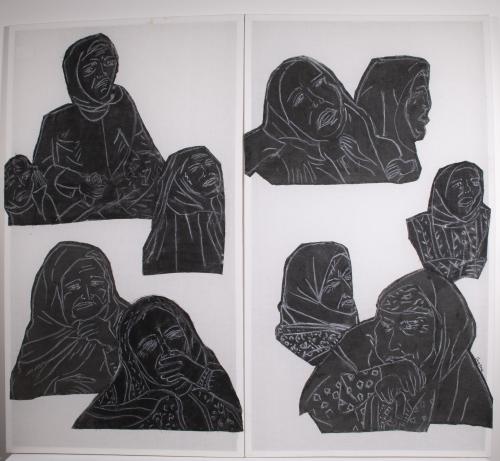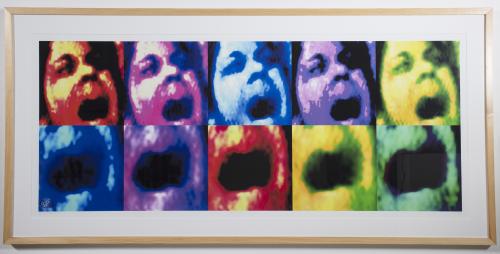
This exhibition presents varying images of the female in Palestinian art produced by successive generations of male and female artists from the 1970s up to the present. The works selected encompass both changes in the intellectual and visual approaches underlying representations of the female form. The diversity of form, content and artistic media selected for the exhibition in many ways parallel the changing social, economic, political and gendered environment prevailing in Palestine. The collection constitutes an affluent reflection on women, their status and representation through various artistic modes and concepts. The viewer is thus invited to contemplate in the reason behind employing the figure of women in these works; what is she being used to represent and how is she made visible? How the image of women is received and interpreted? And what do these images have to say to us about our changing times, about perspectives on Palestinian women or about the idea of Palestine itself? And do male and female artists treat women as a subject (or object) in the same or different ways? To this end, four pillars make up the curating of this exhibition: political representation, the frame of heroism, indications of loss and hope, and the question: where does the body stand?
The idea of this exhibition was brought to fruition by the enigmatic exchange and innovative dialogue that took place between Birzeit University Museum and the Institute of Women’s Studies (IWS). As importantly, the exhibition would have not been realized without the generous sponsorship of the Institute of Women’s Studies (IWS).
In the Frame of Heroism
The 1970s were an important decade for visual production dominated by the iconic image of Palestinian women, who in their traditional embroidered dresses became symbols of national struggle and identity. The female figure in these works became the signifier of the land, steadfastness and national sacrifice as expressed in the two works of Suleiman Mansour; “Village Awakening” (1978) and “Palestine” (1978). In these works, a Palestinian woman is placed at the center of the painting in an upright position gazing into the distance. This mode of representation attributed the figure a monumental and commemorative peculiarity. Despite the various active roles women played in the national struggle, social work, education culture and arts during that period, male artists favored this symbolically “framed” and static image of the Palestinian woman. Later on, this type of representation became a widespread artistic practice, and for a long time, a means for political and patriotic mobilization. Even in some contemporary works such as “Two Girls from Bethlehem” (2011) by Nabil Anani we find a continuation of the symbolism that was originally fostered in the 1970s. This iconic form of representation of the Palestinian woman as the eternal nation was so powerful and can also be found in the works of other Arab artists who supported the Palestinian revolution. The works by Syrian-born artist, Burhan Karkoutli, constitute an example.
The image of the woman as ‘Palestine’ became almost a permanent trope disseminating in Palestinian collective culture – even beyond the borders and communities of occupied Palestine. The political mobilizational role of this art was greatly enhanced by its re-production and dissemination in the form of posters by the PLO. This made the message of these works accessible to the general public. One such example is Suleiman Mansour‘s painting “Salma” (1978), which was later reproduced as a PLO political poster and distributed under the title “Palestine”. Salma and Palestine thus became synonymous in the collective consciousness of Palestinians. The association contributed immensely to creating a symbolic unity in popular visualization between women and homeland.
“Salma” along with “Fatima” (a female character of political cartoonist Naji Al-Ali’ ), and Ismail Shammout’s “The Newlyweds on the Borders” (1979); Abdul Rahman Al-Muzayyen’s “Dalal Mughrabi” (1979); and the majority of female figures in the works of Kamel Al-Mughanni and many other artists in that period represented the struggle and confrontation in Palestinian conscience. At the same time, artistic technique of the period was limited to drawing, oil painting and printing. Moreover, artistic styles were limited to a direct expressionistic style largely influenced by politically motivated art movements such as the Soviet School of painting or mural art as in the works of Mexican artist, Diego Rivera.
Outside the Frame
In the 1980s and 90s, this representation of the female in Palestinian art began to give way to new trends in form and meaning. The change was led by a new generation of artists who emerged from within new political and cultural realities, while being more connected with the dynamics of contemporary international art practice and its variety of new media including; installation, video, photography, digital art, and others. Led primarily by female artists, this new generation no longer invoked the former symbolism that associated women to the land, national struggle and identity. Instead, their works took a prominent role in critically reforming and restructuring the dominant images of the past both visually and intellectually.
Political Representation
The use of the figure of women as signifiers for various political themes and sensibilities continued in the works of this new generation, albeit in very different ways. Despite that political expression is highly visible in the works of the post-1970s artists, political concerns appear more personalized by individual artists, and their representations more diverse and contemporary. For instance, in her two works “Over My Dead Body” (1988), and “Negotiating Table”, (1983) Mona Hatoum presents a courageous, moral and political stand towards what is happening, not only in Palestine, but in the world at large. Her body takes an actual position in the works, it manifests as a sarcastic yet profound stance on the current play of politics. Similarly, in “Homes for the Disembodied” (2000) Mary Tuma constructs an installation of gigantic and empty dresses hanging in the emptiness of the exhibition space. Though they differ dramatically from the traditional dresses depicted in oil paintings and digital print works of the earlier period, they still offer, albeit through a different artistic language, a highly charged political commentary about diaspora and exile, home and homeland as they address issues pertaining to evacuation and expulsion of Palestinians from their land. Ahlam Shibli in her two works “Fatoma” (2000) and “A Dream” (2000) uses photography as an aesthetic medium to make visible the plight of Bedouin women, whose existence as part of their communities is denied by the Israeli occupation. Again, this is a work with strong political implications that serves as an act of defiance.
Amer Shomali reproduced a portrait of Leila Khaled originally made and disseminated by the PLO in the 1970s. The image of the female guerilla fighter dressed in battle fatigues and carrying a gun became a model for Palestinian female militancy. The image was purposefully staged to present to the general public a model for the Palestinian freedom fighter manifest in the representation of Laila Khaled. Shomali in “The Icon” (2011), a work especially commissioned for this exhibition, brings back this image of Leila Khaled but re-configures it in a contemporary framework. In so doing he criticizes both the political meaning and context of the original photograph, as well as politics in the present. Sarcasm in this unique work is underscored by the material production used which is comprised of 3,500 colored lipsticks.
Signs of Loss and Hope
The overall representation of women in the artworks of the 1970s signified power and steadfastness. The later works, especially those that were produced since the beginning of the second Intifada, a period that witnessed devastating military incursions, massive destruction, martyrdom and death, depict the Palestinian woman relinquished of her former local heroism. Her image now takes up new interpretations that embody pain and loss. This becomes evident in Laila Al-Shawa’s “Scream” (2011), a repeated print of an image of a woman’s scream. In the work, it is unclear if the woman is screaming in anger or anguish in the face of the occupation or against the multiple forms of exploitation in society. The same crying face appears in another of Shawa’s works in this exhibition: “Leashed/Unleashed” (2011). However, in the second case there is an added dimension of sarcasm suggested by the figure of “Cat Woman”, the cartoon female super-hero, who challenges the viewer with her aggressive stance.
In contrast, Vera Tamari in her work “Silent Lament” (2002) represents Palestinian women in a more tragic state where we see women wailing as a reaction to a dramatic and painful loss in their lives. The constantly repeated anguished scenes of mothers’ who had lost their sons that she witnessed every day in the news inspired the artist. The work stands in homage to this dreadful loss, whilst underlying the fact that mothers as well as their sons were victims. Loss is also represented in one work by late young artist Layan Shawabkeh. Her exhibition 'Loss' was loaded with bitterness in anticipation of the loss of her own life due to a chronic illness. The tired bodies of women in her work “Absorption” (2009), painfully embody this sense of impending loss.
Then again, loss and pain can be collective or individual experiences. In her video work “Holding My Breath” (2006) Jumana Abboud uses the feeling of suffocation to reflect the fraught and painful existential situation of Palestinians. She immerses her head in a pan filled with water trying to breathe, and at the same time, trying to avoid suffocation. Existential suffocation is also a theme in the earlier works of Samia Badran, in her work “Portrait” (1978) as well as in “Escape” (1978), where the artist gags herself with wire. Besides these discomforting images of women, in situations of weakness, loss or under threat, other images carry the energy of hope, continuity and resilience in spite of loss and pain. In Raeda Sa’adeh’s work “Penelope” (2011) for instance, the artist creates a metaphorical Palestinian portrayal of the story of “Penelope” who sits amidst the ruins of her destroyed home patiently knitting from a gigantic ball of yarn.
Where is the body?
Among the foundational generation of Palestinian artists, the female body was predominantly used to represent collective issues of identity and national belonging thus precluding the possibility of having an individual rapport with the female image in their works. In terms of the semantics of the female form we find that the majority of these artists portrayed her in traditional clothing, fully covered and entirely confined by decoration and color. This produced an image of the Palestinian woman as a generic stand-in for all women with no individuality or subjective character.
A number of younger artists timidly attempted to defy this dictum, but did not radically depart from it. For instance, Ayman Issa in “Dalaleh” (2000) and Hani Zo’rob in “Wet Dream” (2006) introduced the female body from within a more aesthetic perspective in an attempt to move beyond these boundaries. But it was primarily among female artists in the 1990s where a much more direct and bold relation with the female body finally emerged and in the process raised a lot of debate through their controversial choices of representation. For instance, Inass Yassin in her installation “Mirror” (2004) in this exhibition presents a twofaced image of herself that brings about questions pertaining to the body, identity and the impact of society on what is deemed public and private. Rula Halawani on the other hand provides, a photograph “Untitled” (2011) reflecting a familiar scene of newlyweds seated on the heavily decorated wedding stage. Two women, obviously the mothers of the bridal couple dance in the forefront of the scene. This turns the dark red-filled scene, with its small details and the relationships among each person in the picture into a subject that evokes numerous questions. Raeda Saadeh’s performance piece “Wishes Tree” (2011) employs her body in an act of spiritual emancipation by presenting her own wishes and through also engaging the audience in the act of “wishing”.
The Exhibition was curated by Vera Tamari & Inass Yassin.
Location: The first edition of the exhibition was produced at Birzeit University Museum.Main Gallery.




